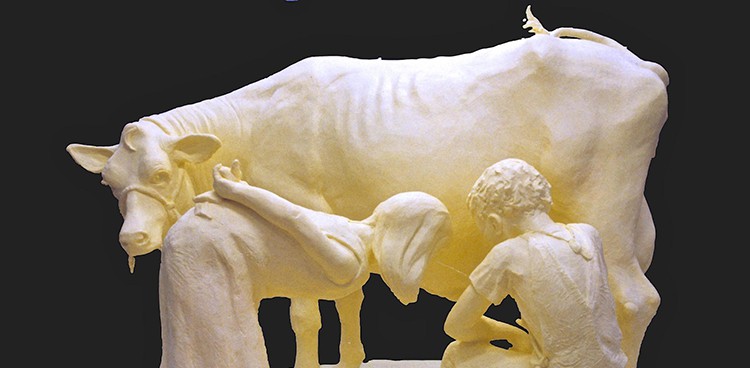
For every region of the United States, the start of summer is celebrated in a distinctly different way. Lobster boils and clam bakes line the shores of New England, filling the air with the wonderful smells of the ocean. In the South, glasses filled with Mint Juleps and Sweet Tea appear on almost every table. But perhaps the most well-known and enjoyed summer tradition belongs to the people of the Midwest, for in the middle of the country, the beginning of summer also marks the beginning of state fair season. To those who have never been to a state fair, I recommend you put it on your bucket list immediately, for there are some things that you’ll see at a fair that you might not find anywhere else (can you say Deep Fried Ribs?). Perhaps one of the most impressive and long-lasting traditions of these state fairs is the artistic anomaly that is butter sculpture. That’s right—butter sculpture.
Originating back in the Middle Ages, butter sculptures first appeared on the royal table, as kings and queens would often host feasts adorned with edible sculptures depicting both humans and animals. Some say the practice draws its roots from an entirely different history in Tibetan Buddhism, where yak butter and flour are mixed with pigment and formed into intricate scenes and mandalas called tormas. However, there is no argument to be had in the beginnings of American butter sculpture. In 1876, Arkansas housewife Caroline Brooks crafted a butter portrait of a young woman entitled “Dreaming Iolanthe,” and she put it on display at the Philadelphia Centennial Exposition. From then on, butter sculptures became one of the main highlights of Midwestern state fairs all across the region.

Photo Credit: “Dreaming Iolanthe, a butter sculpture created by Caroline Brooks for the Philadelphia Centennial Exposition in 1876” by Wikimedia | npr.org
In more recent years, butter sculpture has grown into a much more complex and esteemed art form. Sculptors often use steel as a skeleton for the sculptures and bend it into the general shape of the planned end result. Due to the obvious melting risks of working with butter as a medium, most sculptors work in refrigerated rooms in order to keep the butter at an ideal consistency, coming a long way from the assistance of ice buckets that was popular during Brooks’s time. Having a controlled temperature is especially important nowadays, as many butter sculptures often span over five feet, sometimes using up to 1,500 pounds or 6,000 sticks of butter for a single piece. Along with technological growth, the art of butter sculpture has become much more respected; many sculptors craft edible sculptures full time in butter or other mediums.
Personally, I think that the art of butter sculpture is far too phenomenal to stay contained to seasonal fairs in the Midwest. It’s high time butter artists got the global recognition they so rightly deserve and break out into popular culture, because if there’s one thing that makes any situation better, it’s butter.
Feature Photo Credit: “‘Udder Delight’ by Sharon BuMann” by unknown | Blue Ribbon News




